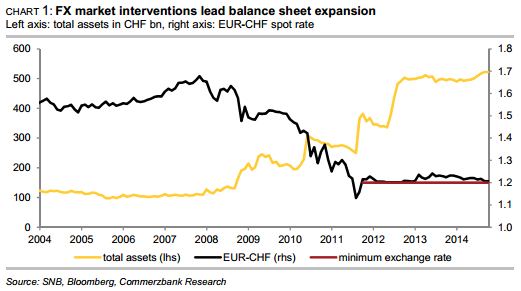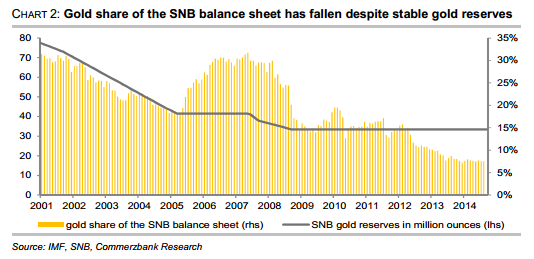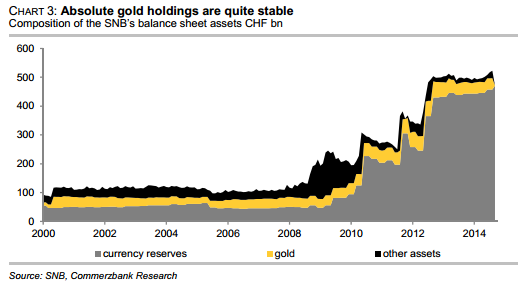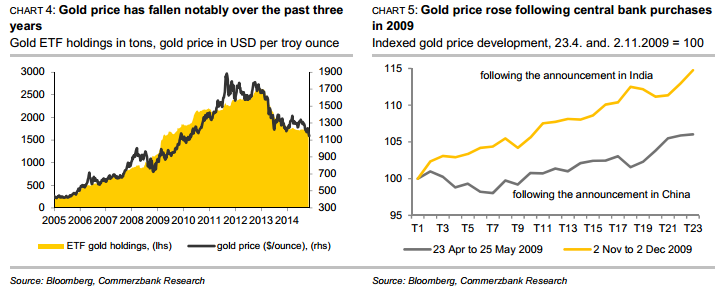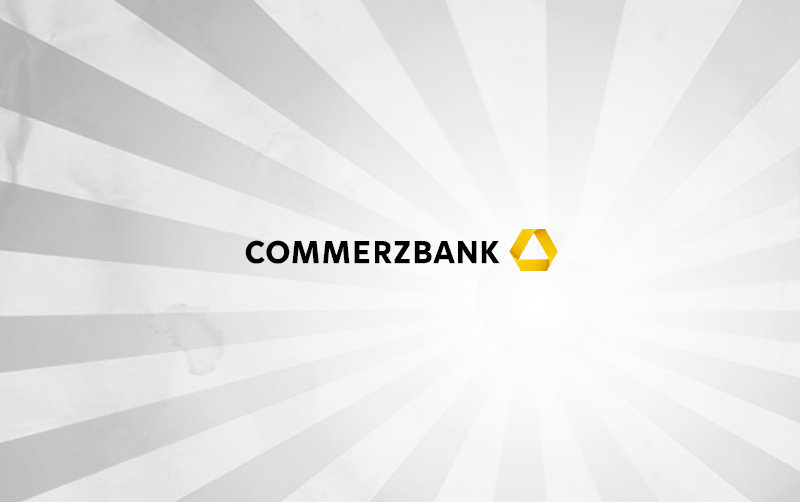Analys
No gold safety net?
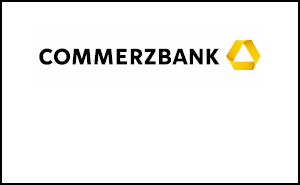
![]() On 30th November Switzerland will hold a “Save our Swiss gold” referendum. Should the petition turn out to be successful the Swiss National Bank would have to buy large quantities of gold and would be limited in its monetary policy. The market (and we as well) considers it unlikely that the petition will be successful. As a result the market reaction would be considerable if the referendum passes.
On 30th November Switzerland will hold a “Save our Swiss gold” referendum. Should the petition turn out to be successful the Swiss National Bank would have to buy large quantities of gold and would be limited in its monetary policy. The market (and we as well) considers it unlikely that the petition will be successful. As a result the market reaction would be considerable if the referendum passes.
What is it all about?
The initiators of the petition “Save our Swiss gold” are of the view that only “gold can be the foundation of a stable franc”. So as to cement these foundations they demand a change of the constitution in the following points:
- The Swiss National Bank is going to be banned from selling gold in the future.
- The gold reserves have to be held in Switzerland.
- In the future the SNB will have to hold a minimum of 20% of its assets in gold.
Within two years of the referendum being passed the Swiss National Bank (SNB) has to return its gold reserves to Switzerland and has five years to reach the minimum requirement of 20%. The organisers of the petition argue that this is the only way of ensuring the independence of the central bank and the long term stability of the Swiss franc. The reason they state is the strong rise of the SNB’s balance sheet. Since the beginning of the financial market crisis six years ago the balance sheet has risen more than fourfold to CHF 522 bn. (chart 1). An important factor in this context is the introduction of the franc’s minimum exchange rate against the euro on 6th September 2011. The latter ensures that the exchange rate cannot ease below 1.20 francs per euro. In order to defend the minimum exchange rate the SNB had been forced to buy considerable amounts of euros over the past years. Since the introduction of the minimum exchange rate the balance sheet has risen by 40%, with the majority of this rise taking place between September 2011 and September 2012. With the easing of the Euro crisis the appreciation pressure on the franc was reduced and therefore SNB’s interventions subsided notably. However, should the ECB begin buying government bonds on a large scale next year the appreciation pressure on the franc is likely to rise again. This would also increase the likelihood of renewed SNB interventions, which in turn would lead to a further expansion of the SNB balance sheet.
The petition demands damage the credibility of the SNB
The petition demand to hold all SNB gold reserves in Switzerland does not limit the SNB. The main advantage of geographically distributing the gold reserves, the possibility to sell the reserves quickly, would become redundant as a result of the ban on selling gold. And as the reserve can no longer be sold in the event of a crisis it no longer constitutes a reserve in the stricter sense and therefore it does not matter whether it is distributed around the globe or sunk in one of the Swiss lakes. If the gold reserves cannot be sold they are “lost” for the Swiss economy and for supporting the franc. However, what does the combination of the sales ban and the 20% minimum gold share in the reserves mean for the SNB’s monetary policy? These two demands limit the central bank’s monetary policy scope considerably and make it more difficult for the SNB to fulfil its mandate: price stability in the sense of a rise of consumer prices of less than 2% per annum.
- A balance sheet expansion to fight deflation would entail gold purchases at possibly higher prices so as to ensure that the minimum requirement of 20% is met. Gold is considered to constitute the ultimate safe haven and therefore gets more expensive if the desire for more security increases. As a result the threshold for an extension of the balance sheet that requires gold purchases might be increased.
- Under certain conditions the SNB’s ability to control inflation with the help of a balance sheet contraction might be limited, as the SNB would no longer be able to contract its balance sheet at will. It would only be possible to reduce assets by reducing non-gold holdings as it would not be allowed to sell gold. As a result the gold holdings determine the minimum size of the balance sheet. A balance sheet contraction over and above that is not possible.
The market would be aware of the SNB’s dilemma, so it would constitute the perfect invitation for the market to bet against the SNB. It would open the door to speculators. The difficulties can easily be illustrated by explaining the significance of the petition demands for the EUR-CHF minimum exchange rate of 1.20.
Under the gold initiative the minimum exchange rate in its current form would have been impossible
The SNB introduced the minimum exchange rate to prevent the additional deflationary pressures caused by the appreciation of the franc. The most important reason behind its success is the SNB’s credibility that it would sell unlimited amounts of francs should that be necessary. The SNB would lose this credibility under the conditions of the gold initiative. In this context two factors are important for speculators:
- (1) If there is a risk that EUR-CHF could ease below 1.20 the SNB is forced to extend its balance sheet with the help of franc sales so as to weaken the franc. The difficulties this would cause were discussed above. After the implementation of the 20% requirement the necessary gold purchases could cause the SNB to hesitate and cause the market to question the SNB’s determination.
- (2) A successive contraction of the balance sheet might be possible to a limited extend only, theoretically until the gold share reached 100%. If the extension of the balance sheet cannot be fully reversed inflation pressure increases after a while. Medium term the target of maintaining monetary stability might come under threat. In line with its mandate of price stability the SNB has to anticipate the long term effects of an expansion of the balance sheet. This might cause the SNB to hesitate before selling francs. As a result the SNB’s promise to do everything to defend the minimum exchange rate would become less credible.
However, short term a positive outcome of the referendum would have little effect on the EURCHF exchange rate. Following the vote the SNB would have five years to meet the minimum requirement of 20% gold holdings. So for the time being it would be able to sell unlimited amounts of francs to defend the 1.20 exchange rate – and it would no doubt do so. It would do so to send out the clear signal that it can and will act.
However, that will not be the case medium to long term. At present the SNB expects a rate of inflation of 0.3% yoy in 2015 – which would not yet allow an exit from the minimum exchange rate strategy. As the requirements of the gold initiative act as an invitation to the market to attack the minimum exchange rate, the SNB would probably be unable to defend the minimum exchange rate long term. Over the coming years the SNB would therefore find it increasingly difficult to maintain the minimum exchange rate in its current form.
As long as the SNB sticks to the minimum exchange rate it is clear though that it would not be able to achieve the requirement to hold 20% gold by contracting the balance sheet. So if the gold initiative was to be successful the SNB would therefore be required to buy substantial amounts of gold, in order to reach the required share of 20% of gold in its assets. This would clearly influence the gold price.
Gold initiative might constitute the turning point for the gold price
As a result of the SNB’s balance sheet expansion the share of the gold reserves in the total balance has fallen continuously over the past few years. Until mid-2008, i.e. before the start of the financial market crisis, it still accounted for more than 20% – the level that the gold initiative would like it to return to. At present the gold holdings account for less than 8% of the balance, sheet without the amount of gold being held having changed during this time (chart 2 and chart 3 below). Since 2008 the reserves have always amounted to 33.44 m ounces (1,040 tons). At current gold price levels this corresponds to CHF 39bn For the gold share to reach 20% again, as demanded by the gold initiative, it would have to rise to CHF 104.5 bn. as long as the total balance remains unchanged. Assuming an unchanged gold price the SNB would have to buy 56.3 m ounces (which corresponds to approx. 1,750 tons) of gold. That would exceed the holdings of all gold ETFs tracked by Bloomberg (chart 4) and would correspond to approx. 60% of the annual global mine production.
Due to the many parameters it is difficult to give the exact purchasing volume required. The SNB balance sheet is likely to increase further next year if the ECB starts its broad-based bond purchases. Under these circumstances the SNB would probably be forced to once again purchase euros so as to defend the minimum exchange rate. So if everything else remains unchanged even larger gold purchases would then be necessary. On the other hand it seems likely that should the referendum end in a win for the gold initiative the gold price would rise. A rise in the gold price on the other hand would lead to a value based increase of the gold reserves’ share of the balance sheet. So that would mean the SNB has to buy less gold. A fall in the gold price would increase the required gold purchases but this is unlikely in view of the market expectations of imminent massive SNB gold purchases.
At present the market considers it relatively unlikely that the initiative will be successful. Current polls put the opponents of the initiative into a clear lead now after first polls had still assumed a majority for the supporters of the initiative. The chances of the initiative’s success have been dampened quite considerably since the executive committee of the Swiss People’s Party (SVP) voted against the initiative with a tight majority. That means the initiative’s only supporter amongst the parties has been lost, as the other parties are opposing the initiative. The SNB itself is also opposing the initiative for the reasons explained above. As hardly anybody expects the initiative to be accepted the effects of a surprise acceptance on the gold price would be even more pronounced. An outcome of that nature would be in a position to form the turning point in the development of the gold price and constitute the end of the 3-year bear market.
How pronounced would the price reaction in case of a vote in favour of the gold initiative be? The reaction of the gold price following the announcement of gold purchases by the Chinese and Indian central banks in 2009 might provide an indication. When the Chinese central bank announced in late April 2009 that it had increased its gold holdings by 454 tons in the previous 6 years the gold price rose by 6% within one month (chart 5). When the Indian central bank purchased 200 tons of IMF gold, a transaction that became public in early November 2009, this caused a price rise of 15% within one month. The even larger amount of gold the SNB would have to buy suggests that the price would rise at least by a similar magnitude. On the other hand the clearly more negative market sentiment compared with 2009 points in the other direction. At the time the gold price had been in a 7-year uptrend whereas it has been in a downtrend for three years now (chart 4).
Analys
OPEC+ will likely unwind 500 kb/d of voluntary quotas in October. But a full unwind of 1.5 mb/d in one go could be in the cards

Down to mid-60ies as Iraq lifts production while Saudi may be tired of voluntary cut frugality. The Brent December contract dropped 1.6% yesterday to USD 66.03/b. This morning it is down another 0.3% to USD 65.8/b. The drop in the price came on the back of the combined news that Iraq has resumed 190 kb/d of production in Kurdistan with exports through Turkey while OPEC+ delegates send signals that the group will unwind the remaining 1.65 mb/d (less the 137 kb/d in October) of voluntary cuts at a pace of 500 kb/d per month pace.

Signals of accelerated unwind and Iraqi increase may be connected. Russia, Kazakhstan and Iraq were main offenders versus the voluntary quotas they had agreed to follow. Russia had a production ’debt’ (cumulative overproduction versus quota) of close to 90 mb in March this year while Kazakhstan had a ’debt’ of about 60 mb and the same for Iraq. This apparently made Saudi Arabia angry this spring. Why should Saudi Arabia hold back if the other voluntary cutters were just freeriding? Thus the sudden rapid unwinding of voluntary cuts. That is at least one angle of explanations for the accelerated unwinding.
If the offenders with production debts then refrained from lifting production as the voluntary cuts were rapidly unwinded, then they could ’pay back’ their ’debts’ as they would under-produce versus the new and steadily higher quotas.
Forget about Kazakhstan. Its production was just too far above the quotas with no hope that the country would hold back production due to cross-ownership of oil assets by international oil companies. But Russia and Iraq should be able to do it.
Iraqi cumulative overproduction versus quotas could reach 85-90 mb in October. Iraq has however steadily continued to overproduce by 3-5 mb per month. In July its new and gradually higher quota came close to equal with a cumulative overproduction of only 0.6 mb that month. In August again however its production had an overshoot of 100 kb/d or 3.1 mb for the month. Its cumulative production debt had then risen to close to 80 mb. We don’t know for September yet. But looking at October we now know that its production will likely average close to 4.5 mb/d due to the revival of 190 kb/d of production in Kurdistan. Its quota however will only be 4.24 mb/d. Its overproduction in October will thus likely be around 250 kb/d above its quota with its production debt rising another 7-8 mb to a total of close to 90 mb.
Again, why should Saudi Arabia be frugal while Iraq is freeriding. Better to get rid of the voluntary quotas as quickly as possible and then start all over with clean sheets.
Unwinding the remaining 1.513 mb/d in one go in October? If OPEC+ unwinds the remaining 1.513 mb/d of voluntary cuts in one big go in October, then Iraq’s quota will be around 4.4 mb/d for October versus its likely production of close to 4.5 mb/d for the coming month..
OPEC+ should thus unwind the remaining 1.513 mb/d (1.65 – 0.137 mb/d) in one go for October in order for the quota of Iraq to be able to keep track with Iraq’s actual production increase.
October 5 will show how it plays out. But a quota unwind of at least 500 kb/d for Oct seems likely. An overall increase of at least 500 kb/d in the voluntary quota for October looks likely. But it could be the whole 1.513 mb/d in one go. If the increase in the quota is ’only’ 500 kb/d then Iraqi cumulative production will still rise by 5.7 mb to a total of 85 mb in October.
Iraqi production debt versus quotas will likely rise by 5.7 mb in October if OPEC+ only lifts the overall quota by 500 kb/d in October. Here assuming historical production debt did not rise in September. That Iraq lifts its production by 190 kb/d in October to 4.47 mb/d (August level + 190 kb/d) and that OPEC+ unwinds 500 kb/d of the remining quotas in October when they decide on this on 5 October.
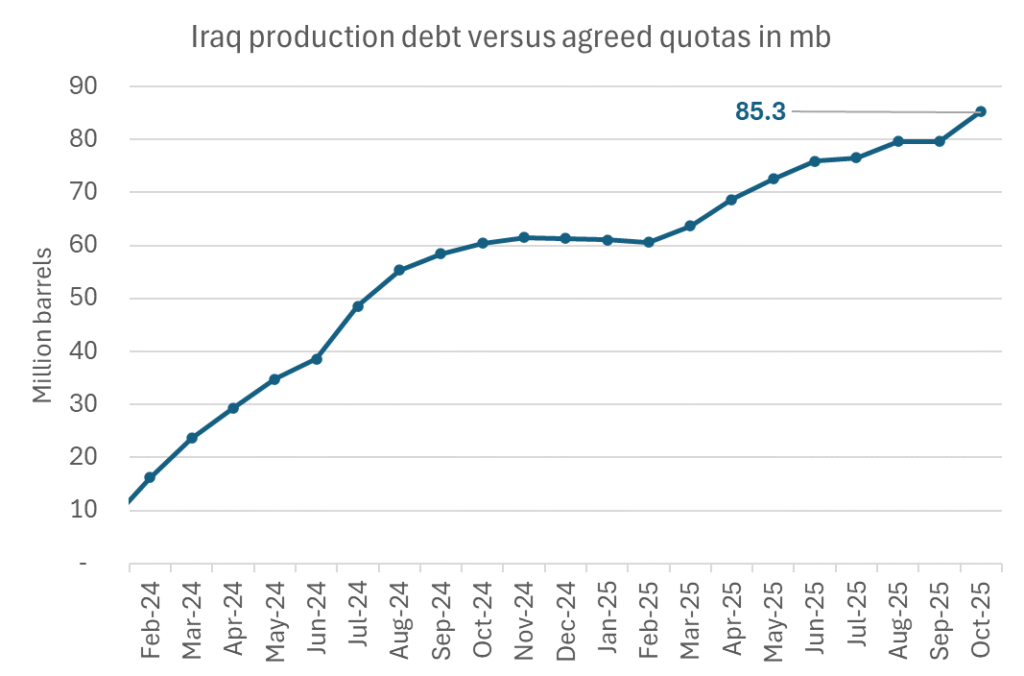
Analys
Modest draws, flat demand, and diesel back in focus

U.S. commercial crude inventories posted a marginal draw last week, falling by 0.6 million barrels to 414.8 million barrels. Inventories remain 4% below the five-year seasonal average, but the draw is far smaller than last week’s massive 9.3-million-barrel decline. Higher crude imports (+803,000 bl d WoW) and steady refinery runs (93% utilization) helped keep the crude balance relatively neutral.

Yet another drawdown indicates commercial crude inventories continue to trend below the 2015–2022 seasonal norm (~440 million barrels), though at 414.8 million barrels, levels are now almost exactly in line with both the 2023 and 2024 trajectory, suggesting stable YoY conditions (see page 3 attached).
Gasoline inventories dropped by 1.1 million barrels and are now 2% below the five-year average. The decline was broad-based, with both finished gasoline and blending components falling, indicating lower output and resilient end-user demand as we enter the shoulder season post-summer (see page 6 attached).
On the diesel side, distillate inventories declined by 1.7 million barrels, snapping a two-week streak of strong builds. At 125 million barrels, diesel inventories are once again 8% below the five-year average and trending near the low end of the historical range.
In total, commercial petroleum inventories (excl. SPR) slipped by 0.5 million barrels on the week to ish 1,281.5 million barrels. While essentially flat, this ends a two-week streak of meaningful builds, reflecting a return to a slightly tighter situation.
On the demand side, the DOE’s ‘products supplied’ metric (see page 6 attached), a proxy for implied consumption, softened slightly. Total demand for crude oil over the past four weeks averaged 20.5 million barrels per day, up just 0.9% YoY.
Summing up: This week’s report shows a re-tightening in diesel supply and modest draws across the board, while demand growth is beginning to flatten. Inventories remain structurally low, but the tone is less bullish than in recent weeks.
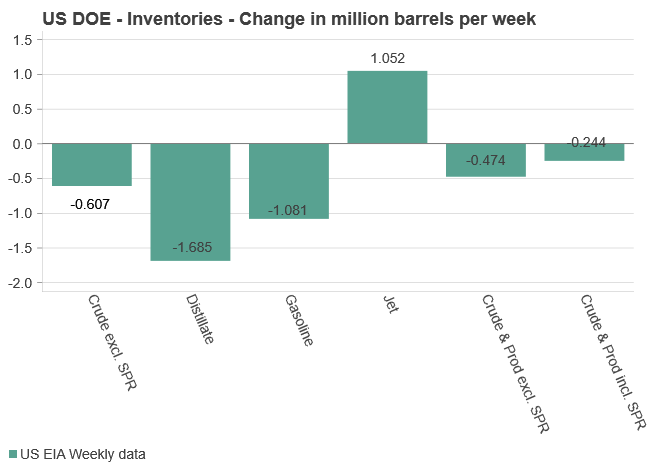
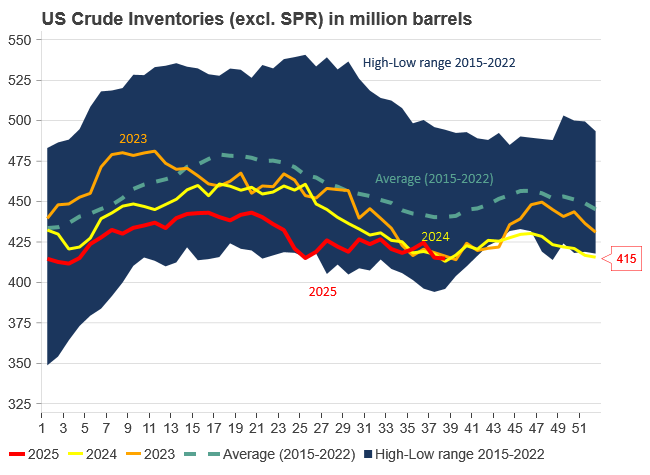
Analys
Are Ukraine’s attacks on Russian energy infrastructure working?

Brent crude rose 1.6% yesterday. After trading in a range of USD 66.1 – 68.09/b it settled at USD 67.63/b. A level which we are well accustomed to see Brent crude flipping around since late August. This morning it is trading 0.5% higher at USD 68/b. The market was expecting an increase of 230 kb/d in Iraqi crude exports from Kurdistan through Turkey to the Cheyhan port but that has so far failed to materialize. This probably helped to drive Brent crude higher yesterday. Indications last evening that US crude oil inventories likely fell 3.8 mb last week (indicative numbers by API) probably also added some strength to Brent crude late in the session. The market continues to await the much heralded global surplus materializing as rising crude and product inventories in OECD countries in general and the US specifically.

The oil market is starting to focus increasingly on the successful Ukrainian attacks on Russian oil infrastructure. Especially the attacks on Russian refineries. Refineries are highly complex and much harder to repair than simple crude oil facilities like export pipelines, ports and hubs. It can take months and months to repair complex refineries. It is thus mainly Russian oil products which will be hurt by this. First oil product exports will go down, thereafter Russia will have to ration oil product consumption domestically. Russian crude exports may not be hurt as much. Its crude exports could actually go up as its capacity to process crude goes down. SEB’s Emerging Market strategist Erik Meyersson wrote about the Ukrainian campaign this morning: ”Are Ukraine’s attacks on Russian energy infrastructure working?”. Phillips P O’Brian published an interesting not on this as well yesterday: ”An Update On The Ukrainian Campaign Against Russian Refineries”. It is a pay-for article, but it is well worth reading. Amongst other things it highlights the strategic focus of Ukraine towards Russia’s energy infrastructure. A Ukrainian on the matter also put out a visual representation of the attacks on twitter. We have not verified the data representation. It needs to be interpreted with caution in terms of magnitude of impact and current outage.
Complex Russian oil refineries are sitting ducks in the new, modern long-range drone war. Ukraine is building a range of new weapons as well according to O’Brian. The problem with attacks on Russian refineries is thus on the rise. This will likely be an escalating problem for Russia. And oil products around the world may rise versus the crude oil price while the crude oil price itself may not rise all that much due to this.
Russian clean oil product exports as presented by SEB’s Erik Meyersson in his note this morning.
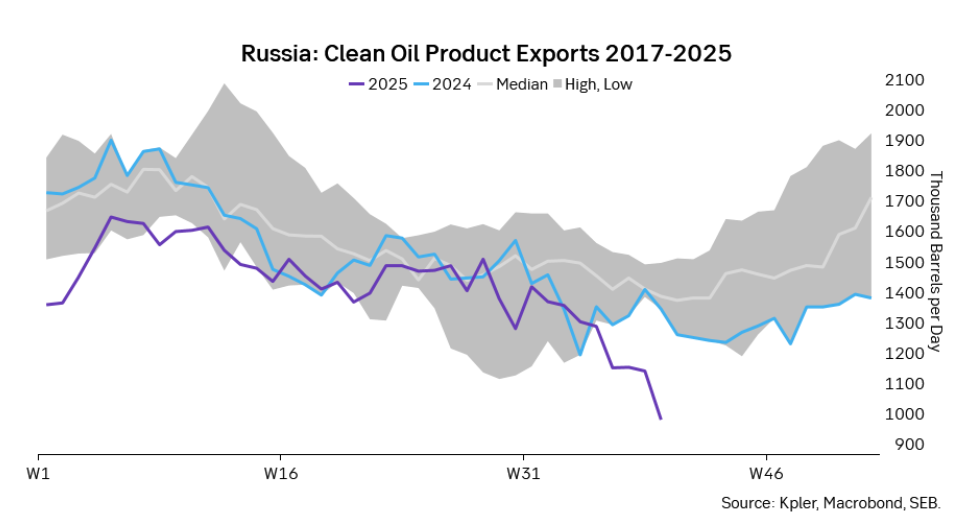
The ICE Gasoil crack and the 3.5% fuel oil crack has been strengthening. The 3.5% crack should have weakened along with rising exports of sour crude from OPEC+, but it hasn’t. Rather it has moved higher instead. The higher cracks could in part be due to the Ukrainian attacks on Russian oil refineries.
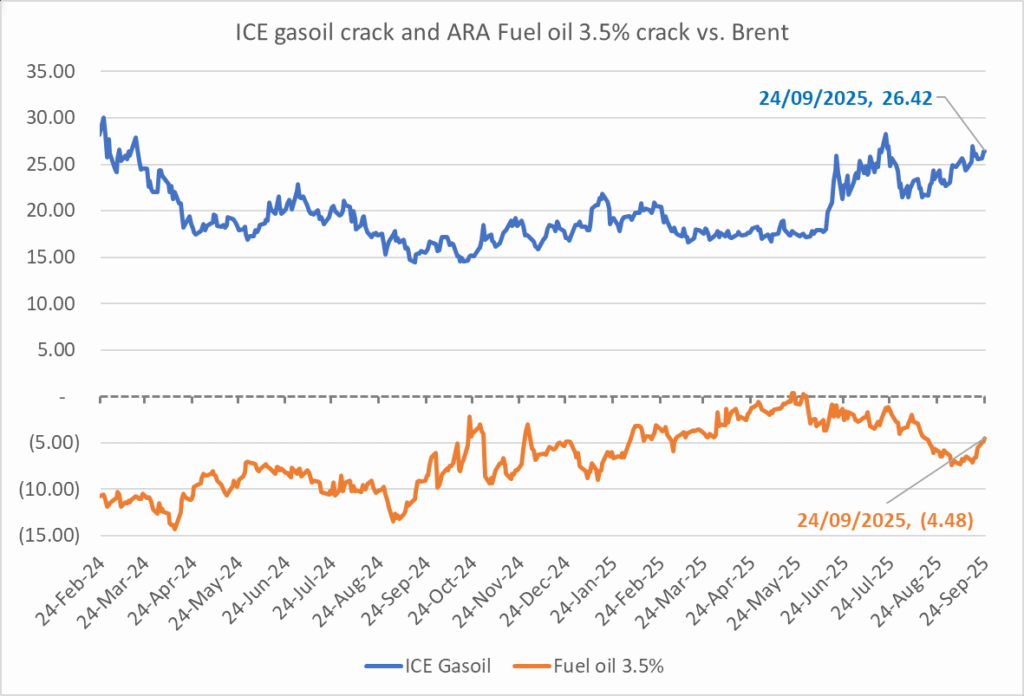
Ukrainian inhabitants graphical representation of Ukrainian attacks on Russian oil refineries on Twitter. Highlighting date of attacks, size of refineries and distance from Ukraine. We have not verified the detailed information. And you cannot derive the amount of outage as a consequence of this.

-

 Nyheter4 veckor sedan
Nyheter4 veckor sedanEurobattery Minerals satsar på kritiska metaller för Europas självförsörjning
-

 Nyheter3 veckor sedan
Nyheter3 veckor sedanMahvie Minerals i en guldtrend
-

 Nyheter4 veckor sedan
Nyheter4 veckor sedanGuldpriset kan närma sig 5000 USD om centralbankens oberoende skadas
-

 Nyheter4 veckor sedan
Nyheter4 veckor sedanOPEC signalerar att de inte bryr sig om oljepriset faller kommande månader
-

 Analys3 veckor sedan
Analys3 veckor sedanVolatile but going nowhere. Brent crude circles USD 66 as market weighs surplus vs risk
-
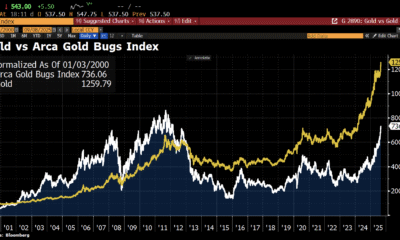
 Nyheter3 veckor sedan
Nyheter3 veckor sedanAktier i guldbolag laggar priset på guld
-

 Nyheter3 veckor sedan
Nyheter3 veckor sedanKinas elproduktion slog nytt rekord i augusti, vilket även kolkraft gjorde
-

 Nyheter2 veckor sedan
Nyheter2 veckor sedanTyskland har så höga elpriser att företag inte har råd att använda elektricitet


